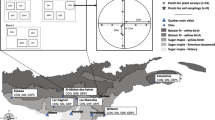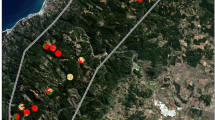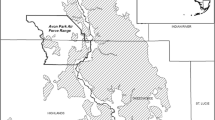Abstract
To determine how vegetation pattern in early successional forests may be related to plant traits and types of disturbance, we measured percent cover of individual taxa annually in a South Carolina Pinus elliottii forest, starting one year before, and ending four years after harvest and tree girdling disturbances were applied. The 17 most important taxa surveyed were grouped into four regeneration strategies chosen a priori, and the spatial patterns of these groups and of the soil were investigated using global variability, semivariograms and kriged maps. We also examined spatial correlations across years, across taxa, and between species and soil disturbance. Seed bank taxa represented by Dichanthelium spp. increased rapidly and formed large patches, and then quickly declined. Taxa that regenerate by newly dispersed seeds, represented by Rhus copallina and Rubus spp. occurred at first in a few patches, and became widespread later. Stump sprouters, represented by Quercus spp. and Myrica cerifera, had rapid increases in cover, but their spatial patterns were largely determined by their pre-disturbance patterns. Prunus serotina, which relies on both sprouting and dispersed seed, had moderate cover and a random distribution. Within-species temporal correlation of spatial pattern was lower in girdled than in harvested plots, and was not clearly related to regeneration strategy. Forest floor disturbance was patchy and affected the pattern of Dichanthelium spp. in the harvested plots. Negative correlations between herbs and woody plants in harvested plots reflected the role of biotic (i.e., successional) filters on vegetation pattern. Surprisingly, no spatial correlations were detected between the nitrogen fixer, Myrica cerifera and other taxa in this N-limited system. In comparing the spatial and temporal patterns, we found kriged maps more informative than analysis of semivariograms alone. The maps and correlation statistics demonstrated that regeneration traits, spatial patterns of soil disturbances, and interactions among taxa influence dynamics of the spatial patterns of the plants. We also demonstrated that disturbance types affected the importance and interactions among these three factors, and caused different spatial patterns of the plant taxa.
Similar content being viewed by others
References
J. Battles A.J. Shlisky R.H. Barrett R.C. Heald B.H. Allen-Diaz (2001) ArticleTitleThe effects of forest management on plant species diversity in a Sierran conifer forest Forest Ecology and Management 146 211–222 Occurrence Handle10.1016/S0378-1127(00)00463-1
S. Beatty (2003) Habitat heterogeneity and maintenance of species in understory communities. Chapter 7 F.S. Gilliam M.R. Roberts (Eds) The Herbaceous Layer in Forests of Eastern North America Oxford University Press New York 177–197
M. Calvino-Cancela (2002) ArticleTitleSpatial patterns of seed dispersal and seedling recruitment in Corema album (Empetraceae): the importance of unspecialized dispersers for regeneration Journal of Ecology 90 775–784 Occurrence Handle10.1046/j.1365-2745.2002.00711.x
N.L. Christensen (2000) Vegetation of the Southeastern Coastal Plain, Chapter 11 M.G. Barbour W.D. Billings (Eds) North American Terrestrial Vegetation. 2nd ed Cambridge University Press New York 397–448
M.L. Cody (2000) ArticleTitleSlow-motion population dynamics in Mojave Desert perennial plants Journal of Vegetation Science 11 251–358
S.L. Collins F. Micheli L. Hartt (2000) ArticleTitleA method to determine rates and patterns of variability in ecological communities Oikos 91 285–293 Occurrence Handle10.1034/j.1600-0706.2000.910209.x
K. Danell L. Edenius P. Lundberg (1991) ArticleTitleHerbivory and tree stand composition: Moose patch use in winter Ecology 72 1350–1357
J.C. Davis (1986) Statistics and Data Analysis in Geology EditionNumber2 John Wiley and Sons New York 646
J.S. Denslow (1985) Disturbance-mediated coexistence of species. Chapter 17 S.T.A. Pickett P.S. White (Eds) The Ecology of Natural Disturbance and Patch Dynamics Academic Press New York 307–323
D. DeSteven (1991a) ArticleTitleExperiments on Mechanisms of tree establishment in old-field succession: seedling emergence Ecology 72 1066–1076
D. DeSteven (1991b) ArticleTitleExperiments on mechanisms of tree establishment in old-field succession: seedling survival and growth Ecology 72 1076–1088
P. Dutilleul (1993) ArticleTitleModifying the t-test for assessing the correlation between two spatial processes Biometrics 49 305–314
J.G. Ehrenfeld X. Han W.F.J. Parsons W. Zhu (1997) ArticleTitleOn the nature of environmental gradients: temporal and spatial variability of soils and vegetation in the New Jersey Pinelands Journal of Ecology 85 785–798
N. Fowler (1982) ArticleTitleCompetition and coexistence in a North Carolina grassland: mixtures of component species Journal of Ecology 70 77–92
S.K. Friedman P.B. Reich L.E. Frelich (2001) ArticleTitleMultiple scale composition and spatial distribution patterns of the north-eastern Minnesota presettlement forest Journal of Ecology 89 538–554 Occurrence Handle10.1046/j.1365-2745.2001.00578.x
F.S. Gilliam M.R. Roberts (2003) Interactions between the herbaceous layer and overstory canopy of eastern forests: a mechanism for linkage. Chapter 8 F.S. Gilliam M.R. Roberts (Eds) The Herbaceous Layer in Forests of Eastern North America Oxford University Press New York 198–223
K.L. Gross K.S. Pregitzer A.J. Burton (1995) ArticleTitleSpatial variation in nitrogen availability in three successional plant communities Journal of Ecology 83 357–367
P.J. Grubb (1977) ArticleTitleThe maintenance of species diversity in plant communities: The importance of the regeneration niche Biological Review 52 107–145
D.A. Griffith (1978) ArticleTitleA spatial adjusted ANOVA model Geographical Analysis 10 296–301
D. Guo P. Mou R.H. Jones R.J. Mitchell (2002) ArticleTitleTemporal changes in spatial patterns of soil moisture: an experimental approach Journal of Ecology 90 338–347 Occurrence Handle10.1046/j.1365-2745.2001.00667.x
D. Guo P. Mou R.H. Jones R.J. Mitchell (2004) ArticleTitleSpatio-temporal patterns of soil nutrients following forest disturbance Oecologia 138 IssueID4 613–621 Occurrence Handle10.1007/s00442-003-1473-3 Occurrence Handle14689301
J.L. Harper J.T. Williams G.R. Sagar (1965) ArticleTitleThe heterogeneity of soil surfaces and its role in determining the establishment of plants from seed Journal of Ecology 53 273–286
P.R.B. Hook I.C. Burke W.K. Lauenroth (1991) ArticleTitleHeterogeneity of soil and plant N and C associated with individual plants and openings in North American shortgrass steppe Plant and Soil 138 247–256 Occurrence Handle10.1007/BF00012252
L.F. Huenneke R.R. Sharitz (1986) ArticleTitleMicrosite abundance and distribution of woody seedlings in a South Carolina cypress-tupelo swamp American Midland Naturalist 115 328–335
E.H. Isaaks R.M. Srivastava (1989) Applied Geostatistics Oxford University Press New York, New York, USA 561
R.B. Jackson M.M. Caldwell (1993) ArticleTitleGeostatistical patterns of soil heterogeneity around individual plants Journal of Ecology 81 683–692
B.G. Jonsson P.A. Essen B. Jonsson (1990) ArticleTitleTreefall disturbance maintains high bryophyte diversity in a boreal spruce forest Journal of Ecology 78 924–936
S. Lavorel B. Touzard J.D. Lebreton B. Clement (1998) ArticleTitleIdentifying functional groups for response to disturbance in an abandoned pasture Acta Oecologica-International Journal of Ecology 19 227–240 Occurrence Handle10.1016/S1146-609X(98)80027-1
M.J. Lechowicz G. Bell (1991) ArticleTitleThe ecology and genetics of fitness in forest plants, part 2. Microspatial heterogeneity of the edaphic environment Journal of Ecology 79 687–696
P. Legendre (1993) ArticleTitleSpatial autocorrelation: trouble or new paradigm Ecology 74 1659–1673
H. Li J.F. Reynolds (1995) ArticleTitleOn the quantification of spatial heterogeneity Oikos 73 280–284
A.J. Lister P. Mou R.H. Jones R.J. Mitchell (2000) ArticleTitleSpatial Patterns in a 40-year-old Slash Pine (Pinus elliottii) Forest in the Coastal Plain of South CarolinaUSA Canadian Journal of Forest Research 30 145–155 Occurrence Handle10.1139/cjfr-30-1-145
M.A.K. Lodhi F.L. Johnson (1989) ArticleTitleForest understory biomass heterogeneity: is “moisture complex” or associated litter the cause? Journal of Chemical Ecology 15 429–438 Occurrence Handle10.1007/BF02027802
C. Meredieu D. Arrouays M. Goulard D. Auclair (1996) ArticleTitleShort range soil variability and its effect on red oak growth (Quercus rubra L.) Soil Science 161 29–37 Occurrence Handle10.1097/00010694-199601000-00005
R.J. Mitchell B.R. Zutter T.H. Green M.A. Perry D.H. Gjerstad G.R. Glover (1993) ArticleTitleSpatial and temporal variation in competitive effects on soil moisture and pine response Ecological Application 3 167–174
P. Mou T.J. Fahey J.W. Hughes (1993) ArticleTitleNutrient accumulation in vegetation following whole-tree harvest of a northern hardwood ecosystem Journal of Applied Ecology 30 661–675
D. Mueller-Dombios H. Ellenberg (1974) Aims and Methods of Vegetation Ecology John Wiley New York, USA 547
A.B. Nicotra R.L. Chazdon S.V.B. Iriarte (1999) ArticleTitleSpatial heterogeneity of light and woody seedling regeneration in tropical wet forests Ecology 80 1908–1926
M.W. Palmer P.M. Dixon (1990) ArticleTitleSmall-scale environmental heterogeneity and the analysis of species distribution along gradients Journal of Vegetation Science 1 57–65
M.W. Palmer (1990) ArticleTitleSpatial scale and patterns of species environment relationships in hardwood forest of the North Carolina Piedmont Coenoses 5 79–87
M.W. Palmer S.D. McAlister J.R. Aévalo J.K. DeCoster (2000) ArticleTitleChanges in the understory during 14 years following catastrophic windthrow in two Minnesota forests Journal of Vegetation Science 11 841–854
J. Pastor Y. Cohen R. Moen (1999) ArticleTitleGeneration of spatial patterns in boreal forest landscape Ecosystems 2 439–450 Occurrence Handle10.1007/s100219900092
S.A.T. Pickett P.S. White (1985) The Ecology of Disturbance and Patch Dynamics Academic Press New York 472
S.A.T. Pickett M.L. Cadenasso (1995) ArticleTitleLandscape ecology: spatial heterogeneity in ecological systems Science 269 331–334
R.A. Reed R.K. Peet M.W. Palmer P.S. White (1993) ArticleTitleScale dependence of vegetation-environment correlations: A case study of a North Carolina piedmont woodland Journal of Vegetation Science 4 329–340
G.P. Robertson K.L. Gross (1994) Assessing the heterogeneity of belowground resources: quantifying pattern and scale M.M. Caldwell R.W. Pearcy (Eds) Exploitation of Environmental Heterogeneity by Plants Academic Press Boston 237–252
R.E. Rossi D.J. Mulla A.G. Journel E.H. Franz (1992) ArticleTitleGeostatistical tools for modeling and interpreting ecological spatial dependence Ecological Monograph 62 277–314
W.H. Schlesinger J.A. Raikes A.E. Hartley A.F. Cross (1996) ArticleTitleOn the spatial pattern of soil nutrients in desert ecosystems Ecology 77 364–374
U. Summer (2000) ArticleTitleBenthic microalgal diversity enhanced by spatial heterogeneity of grazing Oecologia 122 284–287
K.S. Tolliver D.M. Colley D.R. Young (1995) ArticleTitleInhibitory effects of Myrica cerifera on Pinus taeda American Midland Naturalist 133 256–263
C.S.A. Wallace J.M. Watts S.R. Yool (2000) ArticleTitleCharacterizing the spatial structure of vegetation communities in the Mojave Desert using geostatistical techniques Computers and Geosciences 26 397–410 Occurrence Handle10.1016/S0098-3004(99)00120-X
A.S. Watt (1947) ArticleTitlePattern and process in the plant community Journal of Ecology 35 1–22
T. Wiegand D.W. Richard SuffixJr. M. Suzanne (1997) ArticleTitleSimulated plant population responses to small-scale disturbances in semi-arid shrublands Journal of Vegetation Science 8 163–176
J.H. Willems R.K. Peet L. Bik (1993) ArticleTitleChanges in chalk-grassland structure and species richness resulting from selective nutrient additions Journal of Vegetation Science 4 203–212
S.D. Wilson (2000) Heterogeneity, diversity and scale in plant communities M.J. Hutchings E.A. John A.J.A. Stwart (Eds) The Ecological Consequences of Environmental Heterogeneity Blackwell ScienceInc. Malden, MAUSA 53–69
K.D. Woods (2000) ArticleTitleLong-term change and spatial pattern in a late-successional hemlock-northern hardwood forest Journal of Ecology 88 167–282 Occurrence Handle10.1046/j.1365-2745.2000.00448.x
P. Yodzis (1986) Competition, mortality and community structure J. Diamond T.J. Case (Eds) Community Ecology Harper and Row New York 480–491
Author information
Authors and Affiliations
Corresponding author
Rights and permissions
About this article
Cite this article
Mou, P., Jones, R. ., Guo, D. et al. Regeneration Strategies, Disturbance and Plant Interactions as Organizers of Vegetation Spatial Patterns in a Pine Forest. Landscape Ecol 20, 971–987 (2005). https://doi.org/10.1007/s10980-005-7007-0
Received:
Accepted:
Issue Date:
DOI: https://doi.org/10.1007/s10980-005-7007-0




